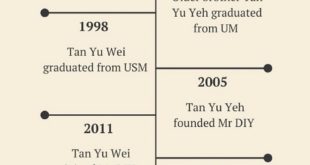Founded back in 2018, One Catalyst Interior (OCI) is now operating with a lean team of 6. However, the founder, Richard Mah did not have a background in Interior Design.
After finishing his studies in Graphic Design and Advertising, he worked as a Graphic Designer for a few years but found that his potential is limited by his job.
And after talking to a few friends, he found there was a gap in the traditional interior design industry.
In his eyes, a traditional interior design firm takes about 3-6 months to complete their work and charges about RM100k for it. But these designs are catered to homeowners who want to live in the unit and not rent it out.
What about the homeowners with a busy lifestyle and want to make money from their investment? They can’t wait 3-6 months for a renovation project and let their investment go idle.
Thus, he left his job with just RM2,000 in the bank and started OCI.

He recalled in the early months of the company, he went through his apartment building and personally handed out over 500 flyers to his neighbours. None of them called back.
To which he learnt that the traditional way of marketing is dead, and if he didn’t go out and perform this task, he wouldn’t know of its ineffectiveness.
He lives by a Chinese saying which, loosely translated, means in order to succeed, you have to carve your own paths and solutions by asking the right questions and not just blindly follow the crowd. After the shift to focus on digital marketing, they finally got their first client, six months in.
One Catalyst Interior uses a simple 5-step strategy to assist their clients in renting out their units.
1. They Have A Quick Setup Process
According to the team, from the moment the keys are handed over, it will only take them 30 days to get your property ready for rental. And based on their track record, they’ve managed to complete 95% of their projects before the 30-day mark too.
The OCI team understands that time is money and with every moment that your property is not rented out, you’re not making money from it. If you go through the traditional means, you won’t be making money for at least 3 months.
Richard gave us a quick breakdown of their workflow:
- Client registers online for an instant quotation,
- The team follows up with the client,
- Get floor plan from the client,
- Send a revised quotation with proposed colour mood boards,
- The team visits the site and confirms with the client,
- The client passes the team the key and work starts.
2. They Source Their Products Locally
OCI sources 95% of their products from local suppliers and factories, with the remaining 5% overseas for specific decorative items.
By supporting local brands, the team is boosting the local economy and they won’t have to deal with shipping delays and costs. And in doing so, they can also show off the craftsmanship of local brands in their units.

He also realised that there’s a lot of hidden costs that usually go into a project and it is hard to win the trust of clients if they don’t know what they’re paying for.
So everything that goes into the unit such as AC, TV, kitchenware and bed frames are all listed in the quotation. So as a client, you will know exactly where the money goes.
Richard said that by being transparent about the process, clients are more than happy to work with them again.
3. They Provide A Self-Sterilisation Solution
There is now a lot of anxiety because of COVID-19, and anyone looking to rent a space is looking for reassurance of their health and safety.
To give all parties peace of mind, OCI utilises a water-based, self-sterilisation solution with photocatalyst technology to eliminate microorganisms such as bacteria and virus.
According to the team, the solution is FDA, MOH, MOE and SIRIM approved. It’ll also last a year and used by hospitals and hotels too.
Dictionary Time: Photocatalysis is the process where light energises a mineral which then triggers chemical reactions that breaks down organic matter at a molecular level.

4. They Understand That Personalisation Matters Over Insta-Worthy Aesthetic
When they design a unit, they’ll try to leave spaces where a tenant can add their own spin to the unit and not focus on over-designing.
“Design and feel are very subjective. Our designs are warm, cosy and sustainable. We actually leave spaces in the units so that the tenants can add in their own ‘colours’ after they moved in,” said Richard.
Even though it may look picture perfect, if a rented property is filled with decorations and random clutter, it might make the tenant feel like it’s not their home and they’re merely house-sitting.
On the other hand, if you give them space to put their own touch to the unit, they’ll feel more at home.

5. They Have A ROI-Driven Selection Process To Increase Rental Returns
OCI also has a unique method of approaching the units they design—they won’t work on units that will not give the clients at least an extra RM1,000 after their redesign.
If a client’s unit is incapable of achieving a good ROI after market research, the team will talk to the client, to discuss expectations and offer different solutions.
But if the client is adamant on the redesign, OCI will still do it, but this decision falls on the client’s shoulder.
Richard then gave us a simple example: If a unit took RM30k to work on, and you’ve only managed to get RM300 increase in rent, it’ll take you 100 months (8.3 years) to recuperate the investment that you’ve made on the renovation.
Ultimately, they want their clients to get the best returns possible from their investment.
While they don’t manage tenants, they have contacts with 9 different agencies to list out your properties to a network of over 700 agents, so you can easily get a tenant for your building.
Looking Towards The Future
Understandably, all renovation work had to stop during MCO. Richard then said at the start of MCO, the team had a heartfelt and honest meeting, to make sure everyone is ready mentally and physically.
“No one is left behind in OCI, we practice ‘leaders eat last’—employees first, customers second and shareholders last.”

As for what’s in store for the future of One Catalyst Interior, he told us that they’ve been investing in tech and digitisation as they want to focus on the post-renovation experience.
The team found out that design wasn’t a client’s top priority, but rather communication. The clients wanted easier ways to monitor the progress and faster updates for renovation, tenants, and defects.
“I’m very grateful for the people I’ve met along the journey and of course our customer’s support. We managed to set a small foundation last year and we’re ready for this year and onwards.”
- Find out more about One Catalyst Interior and get an instant quotation from the team here.
Featured Image Credit: One Catalyst Interior



